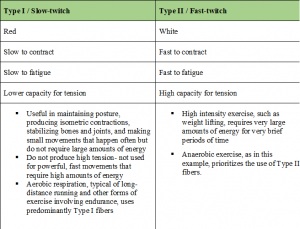4 Muscular Fitness
Module Overview
This module will provide an overview of musculoskeletal anatomy and physiology, training principles for muscular strength and endurance, muscular contractions, and muscle fiber type.
Module Objectives
1. Set SMART (specific, measurable, attainable, realistic, time-sensitive) goals
2. Describe the musculoskeletal system
3. Describe the various types of muscle fibers and muscular contractions
Muscle Physiology
- Muscles make up more than 40% of body mass
- Skeletal muscles act not only to produce movement but also to stop movement such as resisting gravity to maintain posture
- Each skeletal muscle has three layers of connective tissue (mysia) that enclose it and provide structure to the muscle as a whole, and also compartmentalize the muscle fibers within the muscle.
- Each muscle is wrapped in a sheath of dense, irregular connective tissue called the epimysium, which allows a muscle to contract and move powerfully while maintaining its structural integrity
- The epimysium also separate muscle from other tissues and organs in the area, allowing the muscle to move independently
- Inside each skeletal muscle, muscle fibers are organized into individual bundles, each called a fascicle, by a middle layer of connective tissue called the perimysium
- The fascicular organization is common in muscles of the limbs; it allows the nervous system to trigger a specific movement of a muscle by activating a subset of muscle fibers within a bundle, or fascicle of the muscle
- Inside each fascicle, each muscle fiber is encased in a thin connective tissue layer of collagen and reticular fibers called the endomysium.
- The endomysium contains the extracellular fluid and nutrients to support the muscle fiber. These nutrients are supplied via blood to the muscle tissue.

- Muscle fiber: single muscle cell, usually classified according to strength, speed of contraction, and energy source
- Myofibrils: protein structures that make up muscle fibers
- Hypertrophy: increased size of muscle fiber
- Atrophy: decrease in size of muscle fiber
- Atrophy over time due to aging is known as sarcopenia
- Hyperplasia: increase in number of muscle fibers
Muscle Fiber Types

Muscle Units
- Motor unit: a motor nerve (one that initiates movement) connected to one or more muscle fibers
- Muscle learning: improvement in the body’s ability to recruit motor units, brought about through strength training

Resistance Exercises
- Eccentric (pliometric) loading: placing load on the muscle while it is lengthening
- Plyometrics: rapid stretching of a muscle group undergoing eccentric stress (the muscleis exerting force while it lengthens), followed by a rapid concentric contraction
- Speed loading: moving a load as rapidly as possible
- Kettlebell: a type of speed loading using an iron ball with a connected handle; highly ballistic
Resistance Terms
- Tendon: tough band of fibrous tissue; connects a muscle to a bone or other body part and transmits force exerted by muscle
- Ligament: tough band of tissue; connects ends of bones or supports organs
- Cartilage: tough, resilient tissue that acts as a cushion between the bones in a joint
- Testosterone: principal male hormone responsible for secondary sex characteristics and increasing muscle size
- Power: ability to exert force rapidly
Muscular Adaptations
- Increased strength of tendons, ligaments, and bones
- Increased storage of fuel in muscles- Increased resistance to muscle fatigue
- Increased muscle endurance
- Increased size of fast-twitch muscle fibers (from a high-resistance program)
- Increased size of slow-twitch muscle fibers (from a high-repetition program)
- Improved coordination of motor units
- Increased utilization of motor units during muscle contractions


Weight Training Safety
- Use proper lifting technique
- Use spotters and collars with free weights
- Be alert for injuries
- Report injuries to your instructor or physician
- R-I-C-E (Rest, Ice, Compression, Elevation)
- Possible signs of overtraining include a lack of progress, chronic fatigue, decreased coordination, and chronic muscle soreness
- Consult a physician if unusual symptoms occur
Strength Training Programs Criteria
- Repetition maximum (RM): maximum amount of resistance that can be moved a specified number of times
- 1-RM is the maximum amount of weight that can be lifted one time; 5-RM is the maximum weight that can be lifted five times
- Repetitions: number of times an exercise is performed during one set
- Set: group of repetitions followed by rest
- The length of a rest interval depends on the amount of resistance/training goal
- If you desire greater increases in strength, increase the load and the number of sets and decrease the number of reps
- For endurance, choose 40–60% of your maximum 1 RM to perform more reps
- Periodization (cycle training) in which the sets, reps, and intensity of exercise vary, may be useful for gaining strength
- ACSM recommends two or more non-consecutive days a week for weight training
- Allow at least one day of rest
- A complete weight training program works all the major muscle groups
- Important to balance exercises between antagonistic muscle groups
- Exercise the large-muscle groups first and then the small-muscle groups
- Order exercises to work opposing muscle groups in sequence
- Do a general warm-up and a specific warm-up for the exercises by doing repetitions with lighter weights
- For cool-down, relax for 5 to 10 minutes after exercising
- Post-exercise stretching may prevent post-exercise soreness

References
- https://www.acsm.org/all-blog-posts/certification-blog/acsm-certified-blog/2019/07/31/acsm-guidelines-for-strength-training-featured-download
Media Attributions
- fiber types

